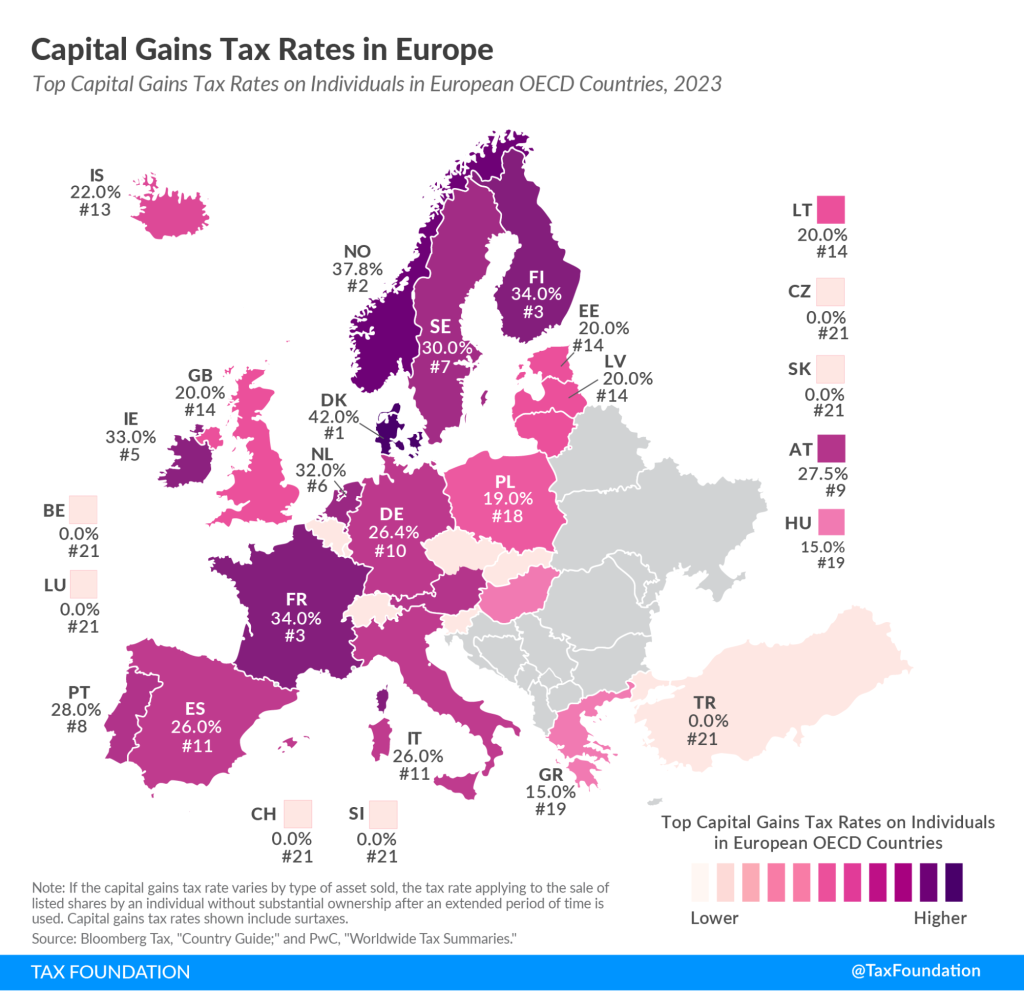Local: Managing Taxes and Fees in Stock Trading in EU
أهداف تعلم الدرس:
- تعرف على capital gains tax (CGT) و dividend tax regimes across different European countries and how these taxes can impact investment returns.
- Explore strategies for managing and potentially reducing tax liabilities on capital gains and dividends, such as holding investments long-term, utilizing tax-loss harvesting, and investing through tax-efficient accounts.
- Understand the variety of fees associated with stock trading in Europe, including brokerage fees, custodial fees, and transaction costs, and how they can vary by broker and type of trading account.
- Gain insight into the financial landscape of European stock trading to make informed decisions about where and how to invest, considering the impact of taxes and fees on overall investment profitability.
28.1 إدارة الضرائب والرسوم في تداول الأسهم
In Europe, managing taxes and fees associated with stock trading is crucial for investors to maximize returns and reduce costs. Different European countries have varying tax systems, but the most common taxes that affect stock traders include ضريبة الأرباح الرأسمالية و dividend tax. Additionally, investors must consider fees related to brokerage services, transaction costs, and custodial fees, which can vary across the EU region.
Capital Gains Tax in Europe
ضريبة الأرباح الرأسمالية (CGT) is imposed on the profit made when you sell a stock for more than you paid for it. The tax rate and conditions vary significantly across European countries, but many apply a tax on both short-term and long-term gains.
- فرنسا: Capital gains are taxed at a flat rate of 30%, which includes both income tax and social contributions.
- ألمانيا: Germany imposes a 26.375% tax on capital gains, including a solidarity surcharge.
- United Kingdom: In the UK, capital gains tax ranges from 10% to 20%, depending on your income level and the amount of profit. Investors also benefit from a capital gains tax-free allowance of £12,300 (as of 2024).
- إسبانيا: Spain taxes capital gains at progressive rates, ranging from 19% to 26%, depending on the amount of profit.
Managing Capital Gains Tax: European investors can reduce their tax liability by holding investments for longer periods, as some countries have preferential tax rates for long-term investments. Additionally, capital gains can be offset by tax-loss harvesting, where investors sell underperforming assets to reduce taxable gains.
28.2 Dividend Tax in Europe
Dividends are also subject to taxes across Europe, and rates vary from one country to another. Many European countries levy a withholding tax on dividends, which can be reduced through tax treaties, especially for foreign investors.
- فرنسا: Dividends are taxed at 30%, which includes income tax and social security charges. French investors may elect for a progressive income tax regime, depending on their overall income.
- ألمانيا: Dividends are taxed at 26.375%, similar to capital gains tax, including a solidarity surcharge.
- United Kingdom: The UK has a tax-free dividend allowance of £1,000 (as of 2024), with dividend tax rates ranging from 8.75% to 39.35%, depending on income level.
- إسبانيا: Spain taxes dividends at progressive rates, ranging from 19% to 26%.
Managing Dividend Taxes: European investors can minimize their dividend tax burden by using tax-efficient accounts، مثل Individual Savings Accounts (ISAs) in the UK, or خطط التقاعد in other European countries, where dividends may be shielded from taxation. In cross-border investments, checking for applicable tax treaties between the countries of residence and investment can help reduce withholding taxes on dividends.
شكل: Top Capital Gains Tax Rates on Individuals in European OECD Countries, 2023
وصف:
This map illustrates the capital gains tax rates on individuals across European OECD countries as of 2023. The map uses a color gradient to represent tax rates, ranging from 0% (lightest pink) to the highest rates (deep purple). Countries with higher capital gains tax rates include Denmark (42%), Norway (37.8%)، و Finland (34%), while some countries, like بلجيكا, لوكسمبورج، و الجمهورية التشيكية, have 0% capital gains tax rates. The numbers next to each country represent the tax rate percentage and its rank among European countries.
الماخذ الرئيسية:
- الدنمارك has the highest capital gains tax rate at 42%, followed by Norway (37.8%) و Finland (34%).
- Several countries, including بلجيكا, لوكسمبورج، و الجمهورية التشيكية, impose no capital gains tax on individuals.
- The map highlights the variability in capital gains taxation across Europe, reflecting different national tax policies.
تطبيق المعلومات:
Understanding capital gains tax rates is essential for investors considering the sale of assets in different European countries. High capital gains taxes can impact عوائد الاستثمار, while lower rates can incentivize investments in certain countries. For individuals looking to optimize their tax strategies, this data provides insights into tax-efficient investment planning and potential cross-border opportunities.
28.3 Fees in European Stock Trading
In addition to taxes, European investors must consider various fees associated with stock trading. These fees can vary depending on the broker, the exchange, and the type of account used.
- Brokerage Fees: Fees vary across European brokers, with some offering commission-free trading, while others charge a fixed fee per trade or a percentage of the trade’s value. For instance, platforms like DEGIRO و Revolut offer low-cost trading, while traditional brokers may charge higher fees for additional services.
- Custodial Fees: Some brokers charge custodial fees for holding foreign stocks or managing accounts. These fees are more common for international stock investments and are typically charged annually or monthly.
- Transaction Costs: Investors may face transaction fees, including exchange fees and Electronic Communication Network (ECN) fees, especially when trading on major European exchanges like Euronext or the Frankfurt Stock Exchange.
خاتمة
Managing taxes and fees is an essential aspect of stock trading in Europe. Understanding capital gains و dividend taxes and utilizing strategies such as tax-loss harvesting و tax-efficient accounts can help reduce the tax burden on investments. Additionally, comparing brokers and minimizing trading and custodial fees can further enhance the net returns on investments. By carefully considering these factors, investors in Europe can effectively manage the costs associated with stock trading and build a more profitable portfolio.
معلومات الدرس الرئيسية:
- Capital Gains and Dividend Taxes: Vary significantly across European countries, with some nations offering more favorable tax treatments than others. Investors need to be aware of the specific tax implications in the jurisdictions where they hold stocks.
- Tax Management Strategies: Such as using tax-efficient accounts or choosing long-term over short-term investments, can significantly reduce tax liabilities and enhance the profitability of stock investments.
- Brokerage and Transaction Fees: Can vary widely across Europe, affecting the total cost of trading. Investors should carefully select their brokers and trading platforms based on fee structures, services offered, and the overall cost-effectiveness of each option.
- Cross-border Investment Considerations: When investing across borders within Europe, it is crucial to understand the tax treaties and the impact of regulations such as MiFID II, which can influence both tax liabilities and brokerage fees.
كلمة الختام:
Effective management of taxes and fees is essential for successful stock trading in Europe. By understanding the complex tax environments and fee structures, investors can better plan their investment strategies to maximize returns and minimize costs.



